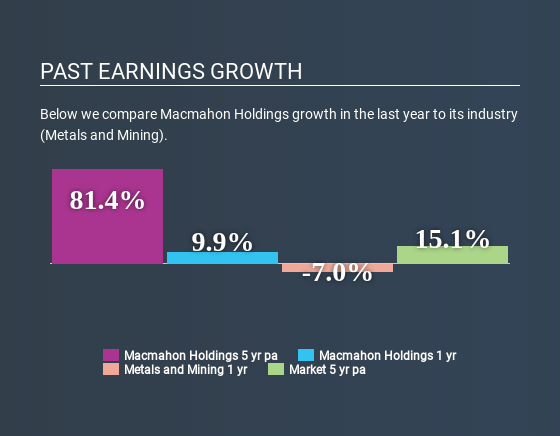Will Weakness in Macmahon Holdings Limited's (ASX:MAH) Stock Prove Temporary Given Strong Fundamentals?

With its stock down 25% over the past three months, it is easy to disregard Macmahon Holdings (ASX:MAH). But if you pay close attention, you might gather that its strong financials could mean that the stock could potentially see an increase in value in the long-term, given how markets usually reward companies with good financial health. Particularly, we will be paying attention to Macmahon Holdings' ROE today.
Return on equity or ROE is a key measure used to assess how efficiently a company's management is utilizing the company's capital. In short, ROE shows the profit each dollar generates with respect to its shareholder investments.
See our latest analysis for Macmahon Holdings
How Is ROE Calculated?
The formula for return on equity is:
Return on Equity = Net Profit (from continuing operations) ÷ Shareholders' Equity
So, based on the above formula, the ROE for Macmahon Holdings is:
11% = AU$51m ÷ AU$467m (Based on the trailing twelve months to December 2019).
The 'return' is the amount earned after tax over the last twelve months. Another way to think of that is that for every A$1 worth of equity, the company was able to earn A$0.11 in profit.
What Has ROE Got To Do With Earnings Growth?
We have already established that ROE serves as an efficient profit-generating gauge for a company's future earnings. Based on how much of its profits the company chooses to reinvest or "retain", we are then able to evaluate a company's future ability to generate profits. Generally speaking, other things being equal, firms with a high return on equity and profit retention, have a higher growth rate than firms that don’t share these attributes.
Macmahon Holdings' Earnings Growth And 11% ROE
To start with, Macmahon Holdings' ROE looks acceptable. Even when compared to the industry average of 11% the company's ROE looks quite decent. Consequently, this likely laid the ground for the impressive net income growth of 81% seen over the past five years by Macmahon Holdings. We reckon that there could also be other factors at play here. Such as - high earnings retention or an efficient management in place.
Next, on comparing with the industry net income growth, we found that Macmahon Holdings' growth is quite high when compared to the industry average growth of 37% in the same period, which is great to see.
Earnings growth is an important metric to consider when valuing a stock. What investors need to determine next is if the expected earnings growth, or the lack of it, is already built into the share price. Doing so will help them establish if the stock's future looks promising or ominous. Is Macmahon Holdings fairly valued compared to other companies? These 3 valuation measures might help you decide.
Is Macmahon Holdings Making Efficient Use Of Its Profits?
The three-year median payout ratio for Macmahon Holdings is 27%, which is moderately low. The company is retaining the remaining 73%. This suggests that its dividend is well covered, and given the high growth we discussed above, it looks like Macmahon Holdings is reinvesting its earnings efficiently.
Moreover, Macmahon Holdings is determined to keep sharing its profits with shareholders which we infer from its long history of paying a dividend for at least ten years. Upon studying the latest analysts' consensus data, we found that the company is expected to keep paying out approximately 28% of its profits over the next three years. Accordingly, forecasts suggest that Macmahon Holdings' future ROE will be 9.8% which is again, similar to the current ROE.
Conclusion
Overall, we are quite pleased with Macmahon Holdings' performance. Specifically, we like that the company is reinvesting a huge chunk of its profits at a high rate of return. This of course has caused the company to see substantial growth in its earnings. Having said that, on studying current analyst estimates, we were concerned to see that while the company has grown its earnings in the past, analysts expect its earnings to shrink in the future. Are these analysts expectations based on the broad expectations for the industry, or on the company's fundamentals? Click here to be taken to our analyst's forecasts page for the company.
If you spot an error that warrants correction, please contact the editor at editorial-team@simplywallst.com. This article by Simply Wall St is general in nature. It does not constitute a recommendation to buy or sell any stock, and does not take account of your objectives, or your financial situation. Simply Wall St has no position in the stocks mentioned.
We aim to bring you long-term focused research analysis driven by fundamental data. Note that our analysis may not factor in the latest price-sensitive company announcements or qualitative material. Thank you for reading.

 Yahoo Finance
Yahoo Finance 
